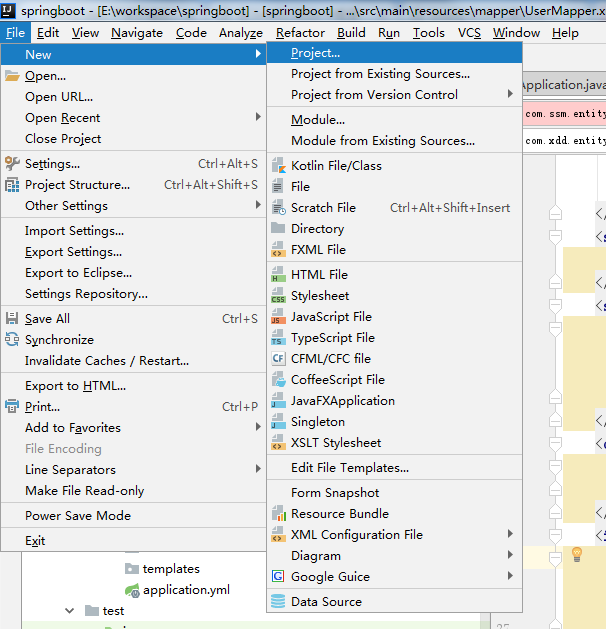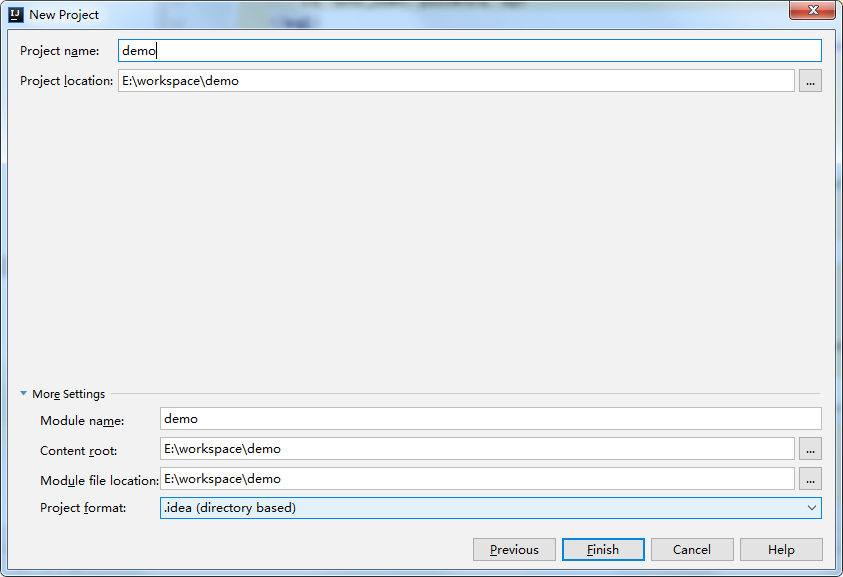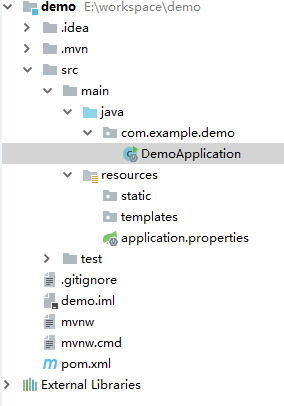spring-boot+mybatis+mysql+maven整合(附帶自己整合的專案)
最近在學習springboot,整合了一個spring-boot+mybatis,看了很多教程,都沒成功,具體的整合流程,大家 看這篇基本就行了,再down下我自己的專案,大家參照著看,希望能幫到大家。
LZ今天自己搭建了下Spring boot+Mybatis,比原來的Spring+SpringMVC+Mybatis簡單好多。其實只用Spring boot也可以開發,但是對於多表多條件分頁查詢,Spring boot就有點力不從心了,所以LZ把Mybatis整合進去,不得不說,現在的框架搭建真的是方便。話不多說,進入正題。
一、java web開發環境搭建
二、Spring boot搭建
1、Intellij idea選單欄File->new->project。

2、選擇左側欄中spring initializr,右側選擇jdk版本,以及預設的Service URL,點選next。

/3、然後填寫專案的Group、Artifact等資訊,helloworld階段選預設就可以了,點選next。

4、左側點選Web,中間一側選擇Web,然後左側選擇SQL,中間一側選擇JPA、Mybatis、MYSQL(LZ資料庫用的是mysql,大家可以選擇其他DB),點選next。

5、填寫Project name 等資訊,然後點選Finish。

至此,一個maven web專案就建立好了,目錄結構如下:

這樣,Spring boot就搭建好了,pom.xml裡已經有了Spring boot的jar包,包括我們的mysql資料連線的jar包。Spring boot內建了類似tomcat這樣的中介軟體,所以,只要執行DemoApplication中的main方法就可以啟動專案了。我們測試一下。
在src/main/java下新建目錄com/demo/entity/User。

package com.demo.entity; public class User { private String name; public String getName() { return name; } public void setName(String name) { this.name = name; } }

相同目錄下新建com/demo/controller/TestBootController。

package com.demo.controller;import com.demo.entity.User; import org.springframework.boot.autoconfigure.EnableAutoConfiguration; import org.springframework.web.bind.annotation.RequestMapping; import org.springframework.web.bind.annotation.RestController; @RestController @EnableAutoConfiguration @RequestMapping("/testboot") public class TestBootController { @RequestMapping("getuser") public User getUser() { User user = new User(); user.setName("test"); return user; } }

spring boot啟動DemoAplication是需要掃描它下面的Controller等類的,所以將DemoApplication移動到com/demo目錄下。還有就是Spring boot啟動預設是要載入資料來源的,所以我們在src/main/resources下新建application.yml:
按 Ctrl+C 複製程式碼按 Ctrl+C 複製程式碼或者將pom.xml中載入資料來源的jar包先註釋掉也可以。
/*<dependency> <groupId>org.mybatis.spring.boot</groupId> <artifactId>mybatis-spring-boot-starter</artifactId> <version>1.3.0</version> </dependency>*/
最終的目錄結構如下,

啟動DemoApplication的main方法,訪問http://localhost:8080/testboot/getuser即可。

三、整合Mybatis
1、整合druid,使用連線池。pom.xml中新增:
<dependency>
<groupId>com.alibaba</groupId>
<artifactId>druid</artifactId>
<version>1.1.0</version>
</dependency>最終的pom.xml檔案:

<?xml version="1.0" encoding="UTF-8"?> <project xmlns="http://maven.apache.org/POM/4.0.0" xmlns:xsi="http://www.w3.org/2001/XMLSchema-instance" xsi:schemaLocation="http://maven.apache.org/POM/4.0.0 http://maven.apache.org/xsd/maven-4.0.0.xsd"> <modelVersion>4.0.0</modelVersion> <groupId>com.arm</groupId> <artifactId>demo</artifactId> <version>0.0.1-SNAPSHOT</version> <packaging>jar</packaging> <name>demo</name> <description>Demo project for Spring Boot</description> <parent> <groupId>org.springframework.boot</groupId> <artifactId>spring-boot-starter-parent</artifactId> <version>1.5.8.RELEASE</version> <relativePath/> <!-- lookup parent from repository --> </parent> <properties> <project.build.sourceEncoding>UTF-8</project.build.sourceEncoding> <project.reporting.outputEncoding>UTF-8</project.reporting.outputEncoding> <java.version>1.8</java.version> </properties> <dependencies> <dependency> <groupId>org.springframework.boot</groupId> <artifactId>spring-boot-starter-data-jpa</artifactId> </dependency> <dependency> <groupId>org.mybatis.spring.boot</groupId> <artifactId>mybatis-spring-boot-starter</artifactId> <version>1.3.1</version> </dependency> <dependency> <groupId>org.springframework.boot</groupId> <artifactId>spring-boot-starter-web</artifactId> </dependency> <dependency> <groupId>mysql</groupId> <artifactId>mysql-connector-java</artifactId> <scope>runtime</scope> </dependency> <dependency> <groupId>org.springframework.boot</groupId> <artifactId>spring-boot-starter-test</artifactId> <scope>test</scope> </dependency> <dependency> <groupId>com.alibaba</groupId> <artifactId>druid</artifactId> <version>1.1.0</version> </dependency> </dependencies> <build> <plugins> <plugin> <groupId>org.springframework.boot</groupId> <artifactId>spring-boot-maven-plugin</artifactId> </plugin> </plugins> </build> </project>

在application.yml中新增資料來源、Mybatis的實體和配置檔案位置。

#預設使用配置 spring: profiles: active: dev #公共配置與profiles選擇無關 mapperLocations指的路徑是src/main/resources mybatis: typeAliasesPackage: com.xdd.entity mapperLocations: classpath:mapper/*.xml --- #開發配置 spring: profiles: dev datasource: url: jdbc:mysql://localhost:3306/test username: root password: root driver-class-name: com.mysql.jdbc.Driver # 使用druid資料來源 type: com.alibaba.druid.pool.DruidDataSource

就這樣就整合完成了!我們測試一下。

import com.xdd.entity.User; import org.springframework.stereotype.Component; public interface UserDao { int deleteByPrimaryKey(Integer id); int insert(User record); int insertSelective(User record); User selectByPrimaryKey(Integer id); int updateByPrimaryKeySelective(User record); int updateByPrimaryKey(User record); }

UserMapper.xml

<?xml version="1.0" encoding="UTF-8" ?>
<!DOCTYPE mapper PUBLIC "-//mybatis.org//DTD Mapper 3.0//EN" "http://mybatis.org/dtd/mybatis-3-mapper.dtd" >
<mapper namespace="com.xdd.dao.UserDao" >
<resultMap id="BaseResultMap" type="com.xdd.entity.User" >
<id column="id" property="id" jdbcType="INTEGER" />
<result column="user_name" property="userName" jdbcType="VARCHAR" />
<result column="password" property="password" jdbcType="VARCHAR" />
<result column="age" property="age" jdbcType="INTEGER" />
</resultMap>
<sql id="Base_Column_List" >
id, user_name, password, age
</sql>
<select id="selectByPrimaryKey" resultMap="BaseResultMap" parameterType="java.lang.Integer" >
select
<include refid="Base_Column_List" />
from user_t
where id = #{id,jdbcType=INTEGER}
</select>
<delete id="deleteByPrimaryKey" parameterType="java.lang.Integer" >
delete from user_t
where id = #{id,jdbcType=INTEGER}
</delete>
<insert id="insert" parameterType="com.xdd.entity.User" >
insert into user_t (id, user_name, password,
age)
values (#{id,jdbcType=INTEGER}, #{userName,jdbcType=VARCHAR}, #{password,jdbcType=VARCHAR},
#{age,jdbcType=INTEGER})
</insert>
<insert id="insertSelective" parameterType="com.xdd.entity.User" >
insert into user_t
<trim prefix="(" suffix=")" suffixOverrides="," >
<if test="id != null" >
id,
</if>
<if test="userName != null" >
user_name,
</if>
<if test="password != null" >
password,
</if>
<if test="age != null" >
age,
</if>
</trim>
<trim prefix="values (" suffix=")" suffixOverrides="," >
<if test="id != null" >
#{id,jdbcType=INTEGER},
</if>
<if test="userName != null" >
#{userName,jdbcType=VARCHAR},
</if>
<if test="password != null" >
#{password,jdbcType=VARCHAR},
</if>
<if test="age != null" >
#{age,jdbcType=INTEGER},
</if>
</trim>
</insert>
<update id="updateByPrimaryKeySelective" parameterType="com.xdd.entity.User" >
update user_t
<set >
<if test="userName != null" >
user_name = #{userName,jdbcType=VARCHAR},
</if>
<if test="password != null" >
password = #{password,jdbcType=VARCHAR},
</if>
<if test="age != null" >
age = #{age,jdbcType=INTEGER},
</if>
</set>
where id = #{id,jdbcType=INTEGER}
</update>
<update id="updateByPrimaryKey" parameterType="com.xdd.entity.User" >
update user_t
set user_name = #{userName,jdbcType=VARCHAR},
password = #{password,jdbcType=VARCHAR},
age = #{age,jdbcType=INTEGER}
where id = #{id,jdbcType=INTEGER}
</update>
</mapper>

public class User { private Integer id; private String userName; private String password; private Integer age; public Integer getId() { return id; } public void setId(Integer id) { this.id = id; } public String getUserName() { return userName; } public void setUserName(String userName) { this.userName = userName == null ? null : userName.trim(); } public String getPassword() { return password; } public void setPassword(String password) { this.password = password == null ? null : password.trim(); } public Integer getAge() { return age; } public void setAge(Integer age) { this.age = age; } }

最後將DemoApplication.java修改一下,讓其掃描dao層介面。

import org.mybatis.spring.annotation.MapperScan; import org.springframework.boot.SpringApplication; import org.springframework.boot.autoconfigure.SpringBootApplication; import org.springframework.boot.web.support.SpringBootServletInitializer; @SpringBootApplication @MapperScan("com.xdd.dao") public class DemoApplication extends SpringBootServletInitializer{ public static void main(String[] args) { SpringApplication.run(DemoApplication.class,args); } }

自己新增controller和service

import java.util.List; import java.util.Map; public interface UserService { public User getUserById(int userId); boolean addUser(User record); }


import org.springframework.beans.factory.annotation.Autowired; import org.springframework.stereotype.Service; import javax.annotation.Resource; import java.util.List; import java.util.Map; @Service("userService") public class UserServiceImpl implements UserService { @Resource private UserDao userDao; public User getUserById(int userId) { return userDao.selectByPrimaryKey(userId); } public boolean addUser(User record){ boolean result = false; try { userDao.insertSelective(record); result = true; } catch (Exception e) { e.printStackTrace(); } return result; } }


@Controller @RequestMapping("/user") public class UserController { @Resource private UserService userService; @RequestMapping("/showUser") @ResponseBody public User toIndex(HttpServletRequest request, Model model){ int userId = Integer.parseInt(request.getParameter("id")); User user = this.userService.getUserById(userId); return user; } }

瀏覽器訪問http://localhost:8080/user/showUser?id=1

以前找別人的教程的時候總是嫌棄人家寫的不詳細,真的自己寫的時候發現很多細節我也詳細介紹不到,比如yml檔案使用,比如資料庫,看來還是要求別人容易,要求自己難。
